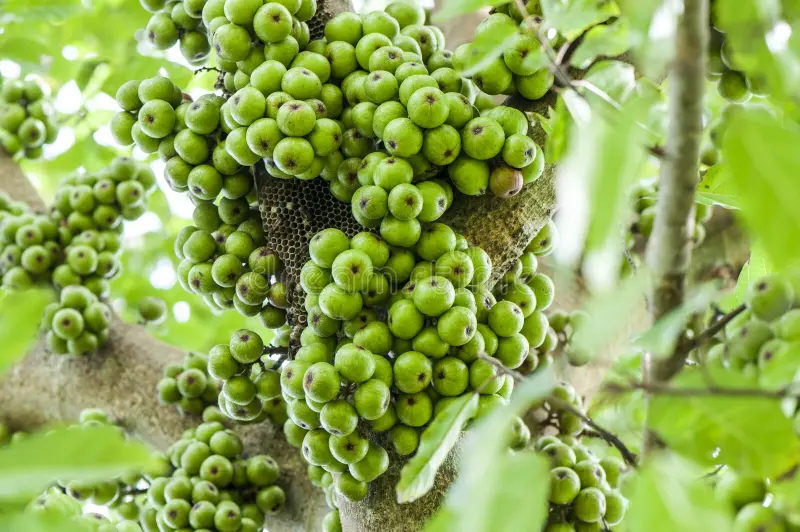Ficus racemosa L.
• Scientific Name: Ficus racemosa
• Family: Moraceae
• Genus: Ficus
• Species: racemosa
Common Names:
• English: Cluster Fig, Gular Tree
• Malayalam: Atthi, Atthi-al, അത്തി,
• Tamil: அத்தி
________________________________________
Synonyms:
• Ficus glomerata (an earlier synonym, still used in some older botanical references)
• Ficus indica (another synonym for the species)
________________________________________
Botanical Description:
• Habit: Ficus racemosa is a small to medium-sized tree that grows up to 10–20 meters in height. It is an evergreen species with a spreading canopy.
• Leaves: The leaves are alternate, simple, elliptical or ovate in shape, and have a rough texture on the upper side, with a light greenish underside. The veins are prominent.
• Flowers: The flowers are small and greenish, borne inside the fig fruit (an arrangement known as a syconium). Ficus trees are unique in having their flowers inside the fruit, and the flowers develop into the fig itself.
• Fruits: The fruit is a fig that is small, round, and initially green, turning yellowish to reddish when ripe. It grows in clusters along the branches and is edible.
• Bark: The bark is smooth and light brown or grayish in color.
________________________________________
Uses:
1. Culinary:
o The ripe fruit of Ficus racemosa is edible and is often eaten fresh or used in local dishes. The fig fruit is sweet when ripe and can be consumed raw or in jams, chutneys, and preserves.
o The unripe fruit is sometimes used in traditional cooking, though it has a more astringent taste and may require cooking before consumption.
2. Medicinal:
o The bark, leaves, and fruit of the tree have been used in traditional medicine to treat a variety of ailments. The plant is known for its anti-inflammatory, antibacterial, and antioxidant properties.
o It is commonly used to treat diabetes, digestive issues, coughs, and respiratory problems. The latex from the tree is used in some cultures as an antiseptic and to treat wounds.
o Leaf extracts are sometimes used to manage fevers, infections, and skin diseases.
3. Industrial Uses:
o The wood of Ficus racemosa is used in construction and furniture making, though it is not as durable as some other species in the Ficus genus.
o The bark can be used for making cordage (rope) in traditional settings.
4. Cultural and Religious Uses:
o In Hinduism, Ficus racemosa is associated with spiritual and ritualistic practices. The tree is sometimes considered sacred, and its fig fruits are offered in certain ceremonies.
o The tree is often found in temples and is planted in gardens for its aesthetic and cultural significance.
5. Ecological Uses:
o As a fig tree, Ficus racemosa plays a significant role in the local ecosystem by providing food for various wildlife, including birds, bats, and insects, which are attracted to its fruit.
o It is also known to be a host plant for certain species of fig wasps, which help in its pollination.

